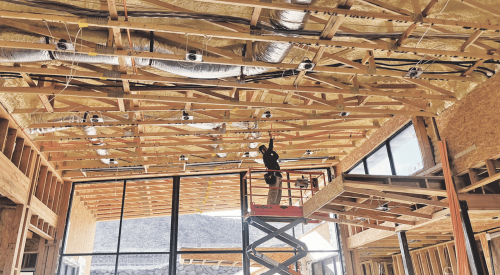|
According to the U.S. Environmental Protection Agency, houses account for 17 percent of greenhouse gas emissions. An easy place for home builders to start incorporating green building practices is as simple as applying roof tiles. Sharp's ND-62RU1 62-watt solar roof modules are one small and cost-effective step the industry can take into the green movement.
"Many builders have been reluctant to get into solar power. It's a tough market," says Jesse Quay, senior design consultant for Sun Light & Power in Berkeley, Calif. "In the next five, maybe 10 years, instead of putting panels on top of the roof, the panels will be the roof," says Quay.
|
|
Solar energy has been fighting an uphill battle of acceptance since the first solar battery was invented in 1883. In 1954, researchers Gerald Pearson, Calvin Fuller and Daryl Chapin designed a silicon solar cell capable of 6 percent energy conversion efficiency with direct sunlight. The team later created an array of several strips of razorblade-size silicon and placed them in direct sunlight, allowing the silicon to absorb electrons beaming from the sun. These electrons were then converted into an electrical current, thus creating the first solar panel. In principle, Sharp's latest roof panels aren't all that different.
Solar roof modules began popping up quite often in residential construction and remodeling during the oil crisis in the 1970s. President Jimmy Carter famously put a solar rig on the roof of the White House during his administration. However, the early solar units were problematic at best; the technology came with high installation costs, had efficiency problems and weren't the prettiest to look at. Another major factor working against the industry was simply quality of work.
"It was a new technology, and many builders and remodelers were putting up solar collectors without having much experience in the field. Ultimately many systems failed and that gave solar a black eye," says Quay.
And it wasn't long after Carter's term that President Ronald Reagan moved into the White House and, in an equally famous publicity stunt, removed the solar collectors from the roof.
Fast forward 20 years: oil prices are up again and the energy crisis has reached critical levels. Solar power is now poised to take off some of the burden placed on our nation's power grid.
"It's very similar in scale and power output to our other products, but the main difference definitely is its design," says Arthur Rudin, director of engineering at Sharp. The solar modules lay flat on the rooftop, interlocking with most standard roof tiles for a smoother look.
"We worked closely with our engineering team, our colleagues in Japan, builders here in the West Coast as well as with roofing manufacturers," says Rudin. "We couldn't design the product without the input from manufacturers. We consulted them to come up with a size that is compatible with most roof systems out there."
At 59 by 15.6 by 1.3 inches, one solar module replaces roughly five standard tiles. Each module features an anti-reflective coating that increases the absorption of light under low-light conditions, expanding operation earlier and later into the day than other modules.
 |
Maximum power output for a standard installation on a 2,500- to 3,000-square foot house is roughly 300 volts with a maximum power current of 7 amps, producing the 62 watts in the product's namesake. And the modules, Sharp says, are quick and easy to install; screwed directly onto the existing roof battens, there's no need for more framing materials nor to screw more holes in the roof. Like concrete tiles, they can be replaced individually without removing surrounding roofing material.
They are designed to deflect water through channels and are resistant to moisture, impact and high winds in addition to carrying a 25-year limited warranty on their power output. Rudin points out, "In a typical home with a typical installation, the solar panels can reduce the home's total power consumption 1/3 to ½. That's big."
We may be past the tipping point when it comes to solar technology, Quay notes. "Forty-two states have incentive programs for net metering, where the utility allows homes to feed back into the grid," he says. Simply put, if more and more homes are powered by solar, they could, in turn, feed power back to the nation's starving energy grid, allowing home owners to sell the power they generate back to utility companies at wholesale prices. Says Quay: "It's free market capitalism at its best."
|














